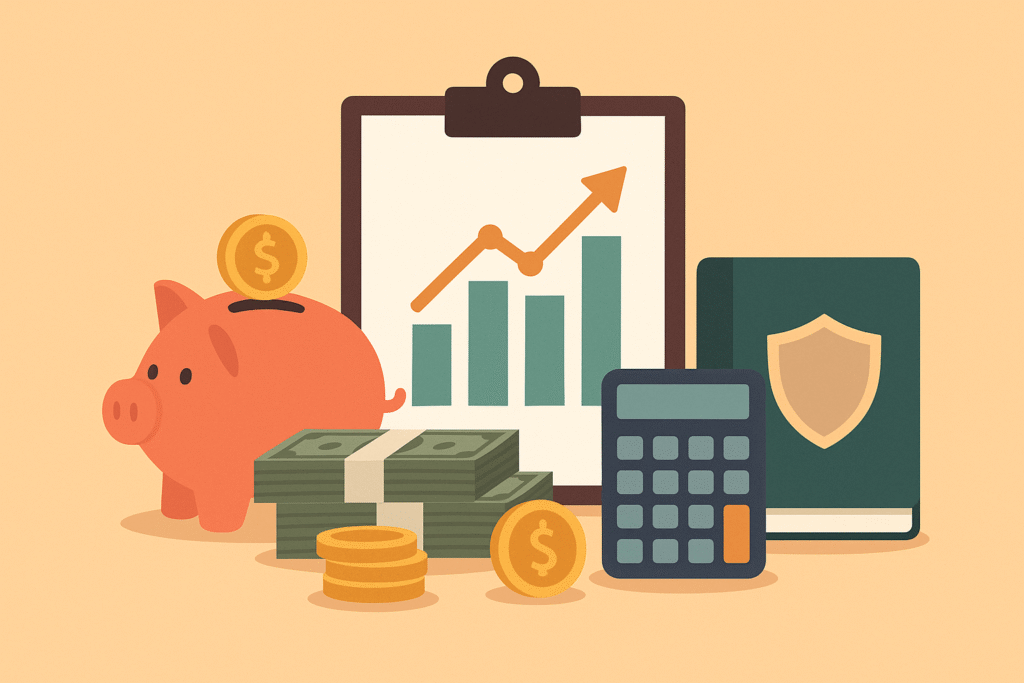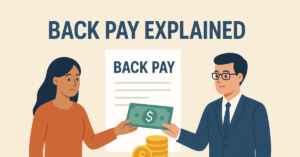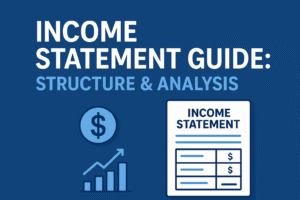Personal finance is the science and practice of managing an individual’s financial decisions and activities. It involves budgeting, saving, investing, tax planning, insurance, estate planning, and debt management. The ultimate goal of personal finance is to achieve financial independence and long-term security while maximizing wealth and minimizing risk.
Quick Fact: According to the FINRA Investor Education Foundation (2023), only 34% of Americans can answer four out of five basic financial literacy questions correctly—indicating a wide gap in personal finance knowledge.
Personal finance operates across the entire lifecycle of a person—from their first paycheck to retirement and beyond. It’s not just about managing money; it’s about understanding how every dollar earned, saved, invested, or spent impacts your future.
The Importance of Personal Finance
In a world of economic uncertainty, rising inflation, and complex financial products, personal finance literacy is no longer optional. Poor financial decisions can have long-term consequences.
Why it Matters:
- Avoiding Debt: Over 60% of U.S. adults live paycheck-to-paycheck (LendingClub, 2024).
- Planning for Emergencies: Only 44% of Americans could cover a $1,000 emergency expense with savings (Bankrate, 2023).
- Building Wealth: The average net worth of U.S. families increases drastically with proper financial planning—e.g., $76,000 for ages 35–44, and $433,000 for 55–64 (Federal Reserve, SCF 2022).
- Retirement Security: 25% of Americans have no retirement savings (PwC Retirement in America Report, 2023).
Bottom Line: Personal finance isn’t just about numbers—it’s the foundation of financial independence, stress reduction, and wealth creation.
Areas of Personal Finance
Personal finance encompasses five core pillars. Each area interacts with and influences the others, making a comprehensive strategy essential.
1. Income
Your income is the cornerstone of your financial health.
Includes:
- Salaries & wages
- Bonuses and commissions
- Rental and dividend income
- Self-employment/side hustle income
- Royalties, pensions
Stat: Median household income in the U.S. was $74,580 in 2023 (U.S. Census Bureau).
Understanding gross vs. net income, tax withholdings, and income streams is vital for budgeting and long-term planning.
2. Saving
Saving is the process of setting aside money for future goals and emergencies.
Key Goals:
- Emergency fund (3–6 months of expenses)
- Short-term needs (vacations, electronics)
- Medium-term goals (wedding, car)
- Long-term savings (home down payment, education)
Stat: 22% of Americans have no emergency savings at all (Bankrate, 2023).
Popular Saving Vehicles:
- High-yield savings accounts
- Certificates of deposit (CDs)
- Money market accounts
3. Spending
Spending must be controlled for a budget to work. It’s categorized as:
- Essential expenses: Rent, groceries, transportation
- Discretionary spending: Dining, travel, subscriptions
Quick Tip: Use the 50/30/20 rule — 50% for needs, 30% for wants, 20% for savings/debt repayment.
Average monthly expenses (BLS Consumer Expenditure Survey 2023):
- Housing: $1,784
- Transportation: $913
- Food: $813
- Insurance/pensions: $715
4. Investing
Investing helps grow wealth beyond inflation. It’s about putting your money into assets that generate returns.
Common Investment Options:
- Stocks
- Bonds
- ETFs and mutual funds
- Real estate
- Commodities (gold, oil)
- Cryptocurrency (higher risk)
Average Market Return: The S&P 500’s average annual return over 50 years is ~10% (adjusted ~7% after inflation).
Key Metrics:
- ROI (Return on Investment)
- Risk tolerance
- Time horizon
- Diversification
5. Protection
Protection preserves your assets and income through insurance, legal planning, and risk mitigation.
Forms of Protection:
- Insurance: Life, health, disability, auto, home
- Estate planning: Wills, trusts, POA
- Emergency funds
- Legal protection: Identity theft protection, umbrella liability policies
Fact: 1 in 4 Americans will become disabled before retirement age (Social Security Administration, 2024).
Personal Finance Services (Detailed Breakdown)
Personal finance services are tools, platforms, or professionals that help individuals plan, manage, and grow their money. These services are increasingly digital, accessible, and personalized—whether you’re managing debt, growing investments, or preparing for retirement.
Here’s a comprehensive breakdown:
1. Wealth Management
What It Is:
Wealth management is a comprehensive financial advisory service that integrates investment management, estate planning, retirement planning, tax strategies, and more—typically offered to high-net-worth individuals (HNWIs).
Who It’s For:
- Individuals with investable assets of $250,000 or more
- Business owners, retirees, and high earners
- Anyone seeking holistic, hands-on financial planning
Benefits:
- Customized investment portfolios
- Tax-efficient strategies
- Succession and estate planning
- Insurance and risk mitigation
Real-World Example:
A 55-year-old business owner approaching retirement uses a wealth manager to:
- Rebalance a $2M portfolio for lower risk
- Set up a charitable trust for tax benefits
- Purchase long-term care insurance
Action Tip:
Ask about fee structure—AUM-based fees (1%) vs. flat or hourly pricing. Consider robo-advisors like Betterment Premium for lower-cost hybrid solutions.
2. Loans and Debt Management
What It Is:
This service includes access to credit (personal loans, student loans, mortgages) and tools for debt reduction (consolidation, counseling, credit repair).
Who It’s For:
- Individuals with high-interest debt
- First-time homebuyers
- Students with educational loans
Benefits:
- Improves cash flow via consolidation
- Lowers interest burden
- Offers structured repayment plans
Stat: The average U.S. household carries $59,580 in total debt (Experian, 2024).
Real-World Example:
A couple refinances a $20,000 credit card debt at 22% APR into a personal loan at 9%, saving $2,600 in interest over 3 years.
Action Tip:
Use the National Foundation for Credit Counseling (NFCC) for certified debt advice, or try apps like Tally or Undebt.it.
3. Budgeting Tools and Services
What It Is:
Digital apps or financial coaching that help track income, expenses, goals, and cash flow patterns.
Who It’s For:
- Anyone new to managing money
- Households living paycheck-to-paycheck
- Freelancers with irregular income
Benefits:
- Real-time tracking
- Alerts for overspending
- Goal setting and visualization
- Behavior-based nudges
Fact: People who use a budgeting tool are two times more likely to achieve financial goals (CFPB, 2023).
Real-World Example:
An individual earning $3,500/month uses YNAB (You Need A Budget) to allocate:
- $1,400 for rent
- $700 for food/utilities
- $1,000 for savings/debt
- $400 for fun
Action Tip:
Try tools like:
- YNAB for zero-based budgeting
- Mint for expense tracking
- EveryDollar for goal budgeting
4. Retirement Planning Services
What It Is:
These services guide users in building retirement savings through employer-sponsored plans, IRAs, annuities, or investment portfolios.
Who It’s For:
- Employees with 401(k)/403(b) plans
- Self-employed individuals
- Anyone 5–30 years away from retirement
Benefits:
- Retirement calculators and forecasting tools
- Employer match optimization
- Tax-efficient distributions
Stat: The average retirement savings for people aged 55–64 is $408,420, but experts recommend at least 8–10x annual income (Fidelity, 2024).
Real-World Example:
A 40-year-old self-employed person uses a Solo 401(k) and contributes $22,500 annually + 20% of business profits as employer.
Action Tip:
Use calculators at Fidelity, Vanguard, or SmartAsset to project retirement needs. Review allocations every 6–12 months.
5. Tax Planning and Preparation
What It Is:
Tax planning helps legally reduce tax liability through deductions, credits, and timing income or capital gains.
Who It’s For:
- High earners
- Business owners
- Investors or landlords
- Parents or students
Benefits:
- Maximize after-tax income
- Strategic use of tax-advantaged accounts
- Avoid costly IRS penalties or audits
Real-World Example:
An investor offsets $15,000 in capital gains using tax-loss harvesting, saving ~$3,000 in federal taxes.
Action Tip:
Use TurboTax or H&R Block for guided filing. For complex situations, hire an EA (Enrolled Agent) or CPA.
6. Risk Management and Insurance Services
What It Is:
Services that protect against financial loss using insurance products and asset protection planning.
Who It’s For:
- Families with dependents
- Property owners
- Entrepreneurs
- Those with high net worth
Benefits:
- Replaces income (life/disability insurance)
- Covers liabilities (auto, homeowners)
- Shields retirement plans from lawsuit claims
Quick Fact: 30% of Americans have no life insurance, and 50% are underinsured (LIMRA, 2024).
Real-World Example:
A freelancer purchases short-term disability insurance covering 60% of income for 6 months due to medical leave.
Action Tip:
Always compare at least 3 quotes. Use sites like Policygenius, Ladder, or Zander.
7. Estate Planning Services
What It Is:
Estate planning organizes asset transfer, guardianship, and medical directives using legal tools like wills and trusts.
Who It’s For:
- Parents of minors
- Seniors or retirees
- Property or business owners
Benefits:
- Avoids probate
- Reduces estate taxes
- Ensures wishes are honored
- Simplifies transitions for heirs
Fact: Only 33% of Americans have a will or estate plan in place (Caring.com, 2025).
Real-World Example:
A couple with two children sets up:
- A living trust to avoid probate
- A medical directive
- Guardianship designations for minors
Action Tip:
Use affordable platforms like Trust & Will, LegalZoom, or hire a local estate attorney for complex situations.
8. Investment Services
What It Is:
These include brokerage platforms, robo-advisors, and financial advisors that help individuals grow wealth through diversified portfolios.
Who It’s For:
- New and seasoned investors
- Long-term planners (retirement, college, home)
- Passive and active investors
Benefits:
- Access to diversified investment products
- Automated rebalancing
- Tax-loss harvesting (in robo-advisors)
- Personalized risk profiling
Real-World Example:
A 30-year-old invests $500/month via Wealthfront, choosing a moderate-risk ETF portfolio and reinvesting dividends.
Stat: Investing $500/month with 7% annual return for 30 years = $566,000+ (compound growth formula)
Action Tip:
Start with platforms like:
- Fidelity, Vanguard, Schwab (DIY)
- Betterment, Wealthfront (robo-advisors)
- M1 Finance, Robinhood (custom portfolios)
9. Insurance Comparison and Optimization Tools
What It Is:
These tools help you shop, compare, and optimize insurance coverage without overpaying or underinsuring.
Who It’s For:
- People looking to save on premiums
- Those seeking bundle deals (home + auto)
- High-risk category (e.g., teen drivers)
Benefits:
- Price transparency
- Customizable coverage filters
- Discounts for bundling, good credit, no-claim bonuses
Real-World Example:
A family saves $600/year by switching auto insurance through The Zebra after comparing 20 providers.
Action Tip:
Use aggregators like:
- Policygenius
- The Zebra
- Gabi
10. Credit Building and Monitoring Services
🔹 What It Is:
Services designed to improve, protect, and monitor your credit score and credit reports.
🔹 Who It’s For:
- Students or new credit users
- People rebuilding after bankruptcy
- Anyone applying for loans soon
🔹 Benefits:
- Alerts for fraud and new inquiries
- Credit score simulations
- Dispute error support
🔹 Real-World Example:
A person increases their credit score from 590 to 710 in 12 months using Experian Boost and Self Credit Builder Loan.
Tip: Check reports at AnnualCreditReport.com—free from all 3 bureaus weekly.
🔹 Recommended Tools:
- Credit Karma
- Experian Boost
- Self
- MyFICO
Personal Finance Strategies
Mastering personal finance requires more than just knowing concepts—it demands the application of effective, proven strategies. Below are the 10 foundational personal finance strategies, now fully elaborated:
1. Know Your Income
Understanding your income goes beyond knowing your salary—it means being aware of all revenue streams, knowing the difference between gross and net income, and managing irregular or freelance earnings.
What to Do:
- Track income sources: Employment, bonuses, freelance, rental income, dividends.
- Calculate net income: After-tax income is what you can actually use for budgeting.
- Account for variability: For freelancers, use a rolling average of 3–6 months.
Example: If you earn $70,000 annually but take home $52,000 after taxes and benefits, your monthly net income is $4,333—not $5,833.
Quick Tip:
Use a digital spreadsheet or app like Tiller or Mint to consolidate income data automatically.
2. Devise a Budget
A budget is your financial blueprint. It tells your money where to go instead of wondering where it went.
Common Budgeting Methods:
- 50/30/20 Rule:
- 50% Needs
- 30% Wants
- 20% Savings/Debt
- Zero-based budgeting: Assigns every dollar a job until your budget = $0.
- Envelope system: Great for cash spenders.
Example:
For $4,000 monthly income:
- $2,000: Rent, food, transport
- $1,200: Travel, entertainment, subscriptions
- $800: Retirement fund + debt repayments
Stat: 82% of people who budget say they feel more in control of their money (NFCC, 2023).
Tools:
YNAB, EveryDollar, PocketGuard, GoodBudget
3. Pay Yourself First
This strategy prioritizes saving and investing before spending. Instead of saving what’s left over, set aside money first.
Steps:
- Automate transfers to a savings/investment account on payday.
- Prioritize emergency fund and retirement accounts.
- Set tiered goals (short, medium, long-term).
Example: On a $5,000 salary, set up auto-transfer of $500 to a Roth IRA or savings account before paying bills.
Quick Fact:
Workers who automatically save through payroll deductions are 15x more likely to build emergency funds (AARP, 2023).
4. Limit and Reduce Debt
All debt isn’t bad—but unmanaged debt can derail financial goals. Focus on debt reduction with a clear repayment plan.
Popular Methods:
- Debt Snowball: Pay smallest balance first for motivation.
- Debt Avalanche: Pay highest-interest debt first to minimize cost.
Stat: U.S. average credit card debt per household is $7,951 (Experian, 2024).
Tips:
- Consolidate high-interest debt with a personal loan or 0% APR card.
- Avoid only paying minimums—it can extend repayment by years.
5. Only Borrow What You Can Repay
This strategy focuses on maintaining a healthy Debt-to-Income (DTI) ratio—ideally below 36%.
Example:
If your monthly gross income is $6,000, your total monthly debt payments should not exceed $2,160.
Borrowing Tips:
- Avoid lifestyle inflation—buy only what you can afford in cash.
- Reassess borrowing based on job stability and emergency fund size.
- Don’t max out credit limits; keep credit utilization below 30%.
Quick Fact: Higher credit utilization lowers your credit score, even if you pay on time.
6. Monitor Your Credit Score
Your credit score determines your interest rates, loan approvals, and even job or rental opportunities.
Key Credit Factors (FICO):
- 35% Payment history
- 30% Credit utilization
- 15% Length of credit history
- 10% New credit inquiries
- 10% Credit mix
Average FICO Score: 717 in the U.S. (FICO, 2025)
How to Improve:
- Pay on time, every time.
- Don’t close old accounts unnecessarily.
- Use tools like Credit Karma, MyFICO, or Experian Boost.
7. Plan for Your Future
This strategy is about goal setting and financial forecasting.
Goals Should Be SMART:
- Specific
- Measurable
- Achievable
- Relevant
- Time-bound
Examples:
- Save $25,000 for home down payment in 3 years.
- Contribute $500 monthly to a retirement account starting age 30.
- Pay off student loans by 2028.
Tip: Use retirement calculators (e.g., Vanguard, Fidelity) to project future savings needs.
8. Buy Insurance
Insurance protects your financial stability against unpredictable risks. Without it, a single event can drain your life savings.
Must-Have Coverages:
- Health Insurance: Avoid medical bankruptcy.
- Term Life Insurance: If you have dependents.
- Disability Insurance: Often overlooked but crucial.
- Home/Renters Insurance: Protects personal property and liability.
Stat: 66% of bankruptcies are tied to medical issues (American Journal of Public Health, 2023).
Tips:
- Compare multiple providers.
- Review policies annually.
- Consider umbrella insurance if your net worth exceeds $500,000.
9. Maximize Tax Breaks
Strategic tax planning saves you money and increases net income.
Tax-Saving Tools:
- 401(k)/403(b): Pre-tax retirement accounts.
- Roth IRA: Tax-free withdrawals.
- HSA: Triple-tax advantage if used for medical expenses.
- 529 Plan: Tax-advantaged education savings.
Deductions & Credits:
- Standard vs. Itemized deduction
- Child Tax Credit
- Earned Income Tax Credit (EITC)
- American Opportunity Credit (college tuition)
Tip: Tax-loss harvesting can offset investment gains with losses to reduce taxable income.
10. Give Yourself a Break
Balance is key. Personal finance isn’t about deprivation—it’s about moderation.
Practices:
- Budget “fun money” to prevent splurges.
- Use reward-based saving (treat yourself when you hit savings goals).
- Schedule financial check-ins monthly—but don’t obsess.
Example: After hitting a milestone (e.g., paying off a loan), reward yourself with a vacation or new purchase—within budget.
Insight:
People who associate budgeting with positivity are 70% more likely to stick to financial goals long-term (Consumer Financial Protection Bureau, 2024).
Personal Finance Skills
Developing key skills is essential for applying personal finance knowledge:
- Budgeting and Forecasting
- Negotiation (lower interest, better bills)
- Research (understanding financial products)
- Record-Keeping
- Discipline & Consistency
- Critical Thinking (separating needs from wants)
Personal Finance Education
Where to Learn:
- Blogs: NerdWallet, Mr. Money Mustache, The College Investor
- Books: “The Total Money Makeover” (Dave Ramsey), “I Will Teach You to Be Rich” (Ramit Sethi)
- Courses: Coursera, edX, Udemy, Khan Academy
- Podcasts: ChooseFI, So Money, The Ramsey Show
Pro Tip: Many public libraries offer free access to paid finance courses and audiobooks.
What Personal Finance Classes Can’t Teach You
Formal education often skips these crucial intangibles:
1. Discipline
No course can replace consistent saving and spending habits.
2. A Sense of Timing
Knowing when to buy/sell, change jobs, refinance, or invest is learned over time.
3. Emotional Detachment
Money decisions should be data-driven—not emotion-driven. Avoid panic selling or fear-based inaction.
Breaking Personal Finance Rules
Examples:
- Not Saving 20% Every Month: Flex when needed; save more later if income allows.
- Investing in Risky Assets: Younger investors may benefit from higher-risk, high-reward assets like emerging tech or crypto.
- Carrying Select Debt: If you earn more investing than you pay in interest, some low-interest debt may be strategic.
Frequently Asked Questions (FAQs)
What Is Personal Finance?
Personal finance is the practice of managing your income, savings, investments, expenses, and protection strategies to meet short- and long-term goals.
What Are the 5 Main Components of Personal Finance?
- Income
- Saving
- Spending
- Investing
- Protection
What Is an Example of Personal Finance?
Setting a monthly budget, contributing to a Roth IRA, and purchasing term life insurance are all examples of personal finance in action.
Why Is Personal Finance So Important?
It enables people to avoid debt, build wealth, plan for emergencies and retirement, and make informed financial decisions.







